Kinder Land Bridge restores coastal prairie and unites Houston’s Memorial Park
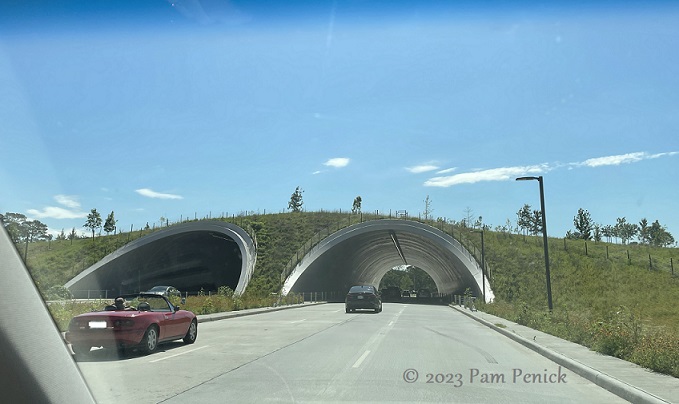
Houston’s Memorial Park, a 1,500-acre urban green space, has for years been sliced and diced by busy roadways, keeping people and wildlife from safe access to all parts of the park. Compounding this design flaw, the heavily wooded park took a hit from Hurricane Ike in 2008 and again during the punishing drought that culminated in 2011. These two events killed off nearly half of the park’s trees.
Local planners might have undertaken a massive tree-planting campaign and called it good. Instead, visionaries reimagined Memorial Park, raising funds and drawing up a master plan for a land bridge to reunite the park, with green space and paths that soar over roadway tunnels, while below-grade a culvert allows additional wildlife passage. The plan also calls for acres of coastal prairie restoration rather than reforestation — a harder sell to the public than trees.
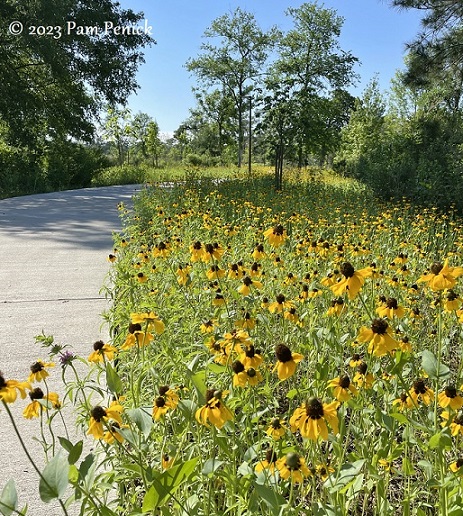
The Kinder Land Bridge and coastal prairie project opened to the public in February 2023. I walked over to see it from the Houston Arboretum a couple weeks ago, following a pedestrian path lined with black-eyed Susans and other native wildflowers.
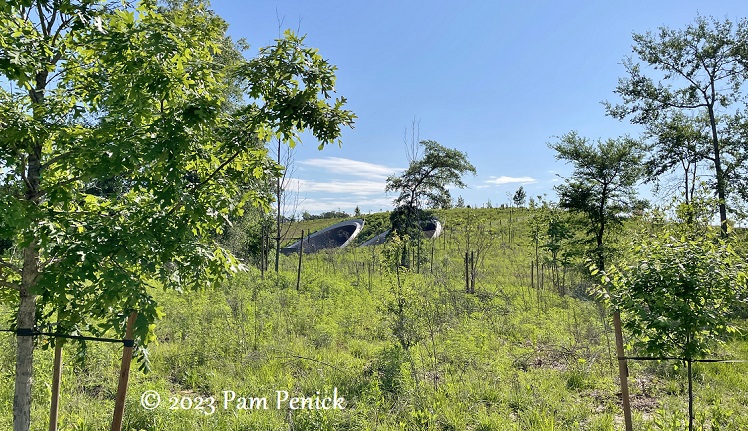
The plantings are still new and do include some trees. But the prairie plants — grasses and herbaceous flowering plants, i.e., forbs — will do the heavy lifting when it comes to soaking up stormwater. Coastal prairie also provides diversity of habitat for wildlife, with pollinator plants that attract insects and seed-bearing grasses for birds and other creatures. Here’s more info from the Memorial Park Conservancy during the planning phase:
“The Land Bridge and Prairie project is an ecological conversion process, and trees removed during this process will either be relocated or repurposed within the Park to support a network of native Gulf Coastal Prairie and Savanna ecologies, as envisioned by the Memorial Park Master Plan. These ecologies once extended over 9 million acres from Corpus Christi, Texas[,] to Lafayette, Louisiana. Today, less than 1% of native Gulf Coastal Prairie habitat remains. Native prairie and savanna ecology is more resilient than the forested habitat that exists in this area today and will promote regional biodiversity of both plant and wildlife species while also helping to absorb and clean stormwater.”
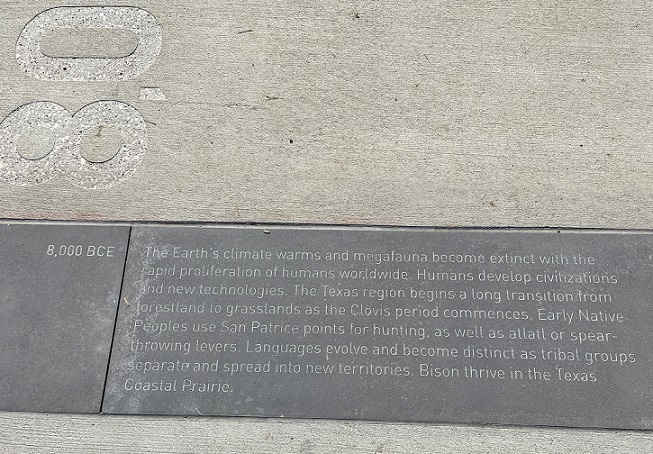
The walk/bike path that arcs up the land bridge is marked by etched paragraphs that give a wide-angle view of the region’s history. Here we are at 8,000 BCE, when Earth’s climate was warming and Texas was transitioning from forests to grasslands. Bison grazed the coastal prairies of Texas.
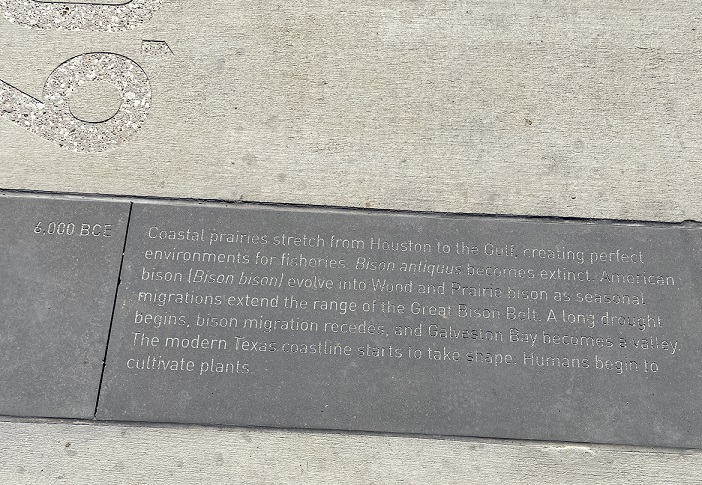
By 6,000 BCE, a long drought turned Galveston Bay into a valley, and the modern Texas coastline was taking shape.
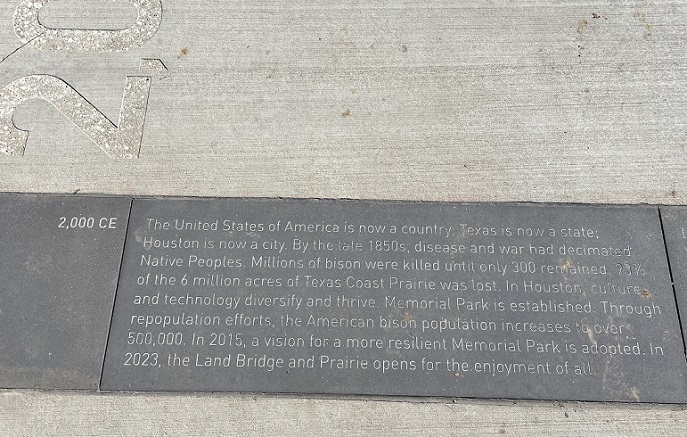
In the current era, the coastal prairie has mostly vanished, but “a vision for a more resilient Memorial Park is adopted.”
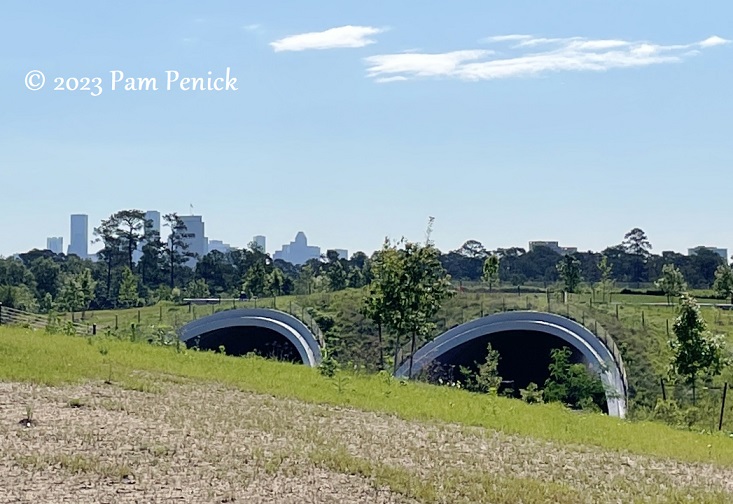
At the top of the land bridge, a circular plaza with built-in benches (not pictured) creates space to rest or people-watch or to hold community gatherings. Markers even indicate where to watch the sunrise on the equinox and solstice. Thomas Woltz, principal of Nelson Byrd Woltz Landscape Architects, the firm that created the park’s master plan, said in a Houston Chronicle interview, “In a fractured society, how do we connect people to each other with a sense of community? One way is to create an experience of awe, and that’s a job for landscape architects….Feeling more connected to society gives me hope for bringing back civility in our society and caring for one another and the places we love, like Memorial Park.”
I love seeing projects like this one greening up and restoring native plants in our over-paved — or over-lawned — cities. Are there others you know about? For another example in Texas, read my post about Native Texas Park at the George W. Bush Presidential Library in Dallas. Way to go, Texas cities!
__________________________
Digging Deeper
Come learn about gardening and design at Garden Spark! I organize in-person talks by inspiring designers, landscape architects, authors, and gardeners a few times a year in Austin. These are limited-attendance events that sell out quickly, so join the Garden Spark email list to be notified in advance; simply click this link and ask to be added. Season 8 kicks off in fall 2024. Stay tuned for more info!
All material © 2025 by Pam Penick for Digging. Unauthorized reproduction prohibited.


What a lovely place. It’s almost worth going to Houston to see. Thanks for the pics.
I love seeing urban parks incorporating native plants — and bringing back endangered ecosystems — like this one.
Thanks for the review! I hope it is well used!
If the day I was there was any example, it will be a popular spot for Houstonians.
Pam, in San Antonio we have a land bridge, also. It connects the two Phil Hardberger parks which are divided by Wurzbach Parkway. Ours is mostly for the animals to go from one part of the park on Blanco Rd to the other on NW Military. People can also walk across, but it was originally intended for the animals use.
The land bridge in San Antonio is on my list to go see. This fall, I hope. Thanks for the info about it!
I also live in San Antonio and love visiting the Phil Hardberger park and exploring the trails with my Border Collie. The land bridge is such a unique and ecologically sensible way to allow wildlife and park visitors to experience both sides of the park separated by a busy highway. So glad to know other cities are incorporating land bridges into their park plans. Thanks for sharing.
I’m glad to know that too. I look forward to seeing San Antonio’s land bridge.
It’s great to see such a thoughtful approach to the restoration/renovation.
I agree!
It’s beautifully executed idea, good for humans and the natural wold too. It is both comforting and encouraging to see such solutions being implemented.
I agree, Chavli. Very encouraging!
Oh, there is hope! I had no idea about this, Pam, so thank you so much for sharing! Houston really has so much to offer once you’re off the highways.
Houston is a wonderful city with so much art, culture, great food, welcoming people, and, increasingly, beautiful urban green spaces. I encourage anyone who thinks Houston is just a spaghetti bowl of highways to explore the Museum District, the Heights, the Rice University area, and so much more.
That’s a positive thing for the community. Nice that more and more are enjoying it. Trees are nice near pathways on a hot day–hopefully the Prairie can have a tree here and there.
Here in SoCal a land bridge is being built over the 405 Freeway to allow wild animals to safely travel from one relatively wild area to another. Positive things still do happen in our country.
It’s good to hear more land bridges are being built across the country, including in your area, HB. A positive thing for sure.
It’s so heartwarming when the experts go against the grain to do what’s best for the earth!
Robin, it certainly is. And projects like these must cost a fortune, so it really is an investment.